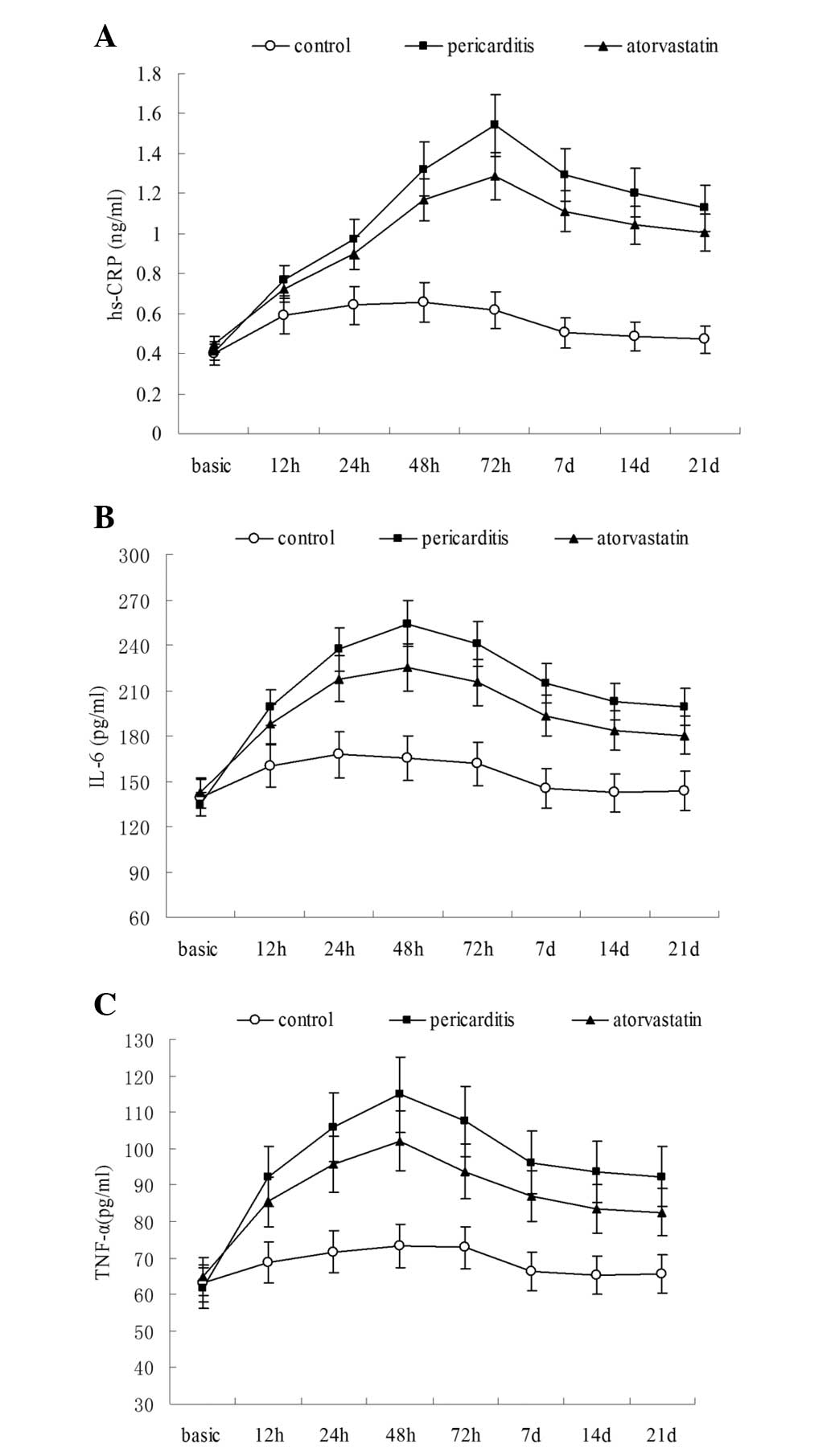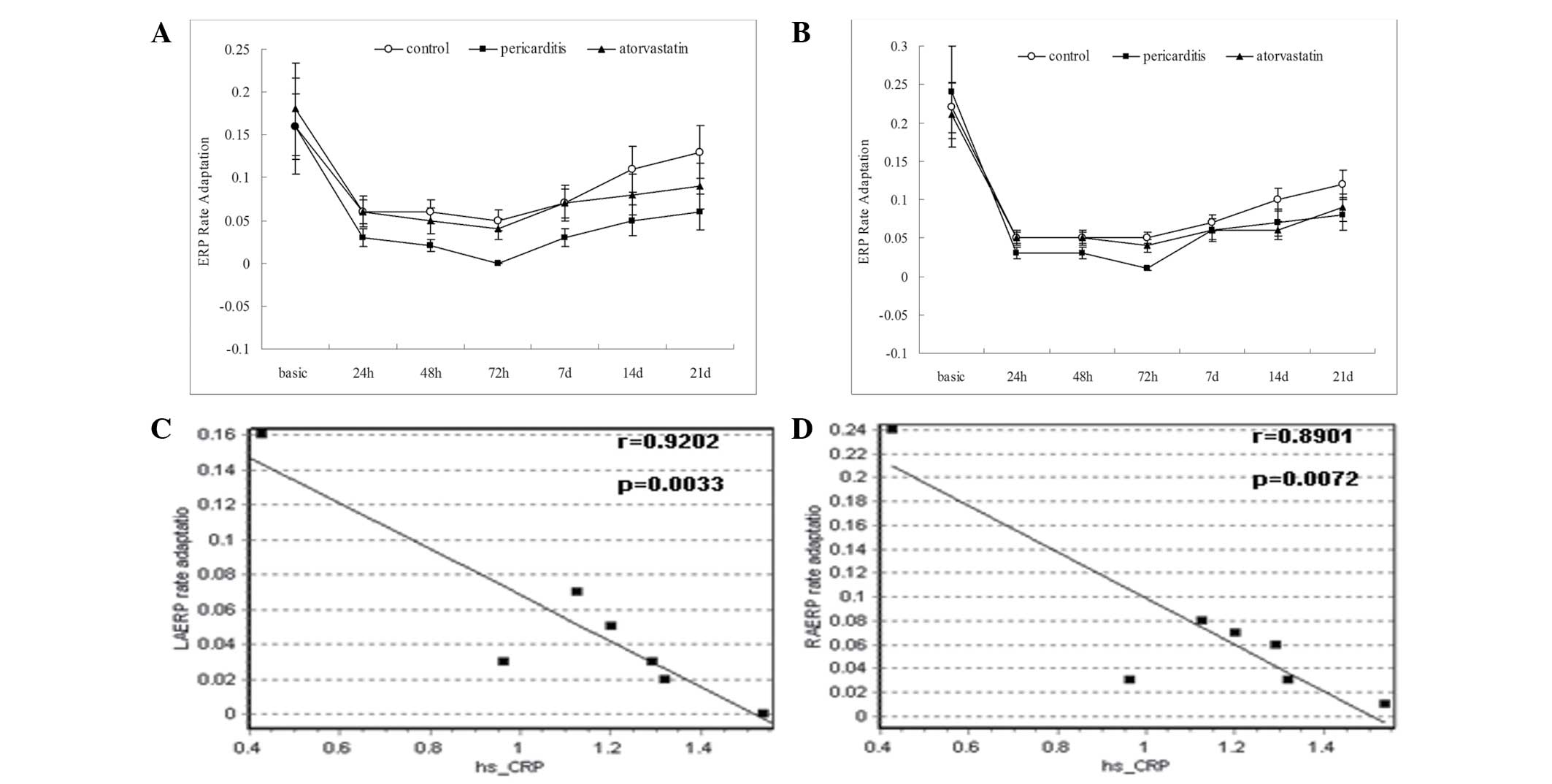|
1
|
Benjamin EJ, Wolf PA, D’Aqostion RB,
Silbershatz H, Kannel WB and Levy D: Impact of atrial fibrillation
on the risk of death: The Framingham Heart Study. Circulation.
98:946–952. 1998. View Article : Google Scholar : PubMed/NCBI
|
|
2
|
Bruins P, te Velthuis H, Yazdanbakhsh AP,
et al: Activation of the complement system during and after
cardiopulmonary bypass surgery: postsurgery activation involves
C-reactive protein and is associated with postoperative arrhythmia.
Circulation. 96:3542–3548. 1997. View Article : Google Scholar : PubMed/NCBI
|
|
3
|
Gaudino M, Andreotti F, Zamparelli R, et
al: The-174 G/C interleukin-6 polymorphism influences postoperative
interleukin-6 levels and postoperative atrial fibrillation. Is
atrial fibrillation an inflammatory complication? Circulation. 108
Suppl 1:II195–II199. 2003. View Article : Google Scholar
|
|
4
|
Frustaci A, Chimenti C, Bellocci F,
Morgante E, Russo MA and Maseri A: Histological substrate of atrial
biopsies in patients with lone atrial fibrillation. Circulation.
96:1180–1184. 1997. View Article : Google Scholar : PubMed/NCBI
|
|
5
|
Chung MK, Martin DO, Sprecher D, et al:
C-Reactive protein elevation in patients with atrial arrhythmias:
inflammatory mechanisms and persistence of atrial fibrillation.
Circulation. 104:2886–2891. 2001. View Article : Google Scholar : PubMed/NCBI
|
|
6
|
Aviles RJ, Martin DO, Apperson-Hansen C,
et al: Inflammation as a risk factor for atrial fibrillation.
Circulation. 108:3006–3010. 2003. View Article : Google Scholar : PubMed/NCBI
|
|
7
|
Sata N, Hamada N, Horinouchi T, Amitani S,
Yamashita T, Moriyama Y and Miyahara K: C-reactive protein and
atrial fibrillation. Is inflammation a consequence or a cause of
atrial fibrillation? Jpn Heart J. 45:441–445. 2004. View Article : Google Scholar : PubMed/NCBI
|
|
8
|
Shiroshita-Takeshita A, Schram G, Lavoie J
and Nattel S: Effect of simvastatin and antioxidant vitamins on
atrial fibrillation promotion by atrial-tachycardia remodeling in
dogs. Circulation. 110:2313–2319. 2004. View Article : Google Scholar : PubMed/NCBI
|
|
9
|
Kumagai K, Nakashima H and Saku K: The
HMG-CoA reductase inhibitor atorvastatin prevents atrial
fibrillation by inhibiting inflammation in a canine sterile
pericarditis model. Cardiovasc Res. 62:105–111. 2004. View Article : Google Scholar : PubMed/NCBI
|
|
10
|
Yared JP, Starr NJ, Torres FK, et al:
Effects of single dose, post induction dexamethasone on recovery
after cardiac surgery. Ann Thorac Surg. 69:1420–1424. 2000.
View Article : Google Scholar : PubMed/NCBI
|
|
11
|
Dernellis J and Panaretsu M: Relationship
between C-reactive protein concentrations during glucocorticoid
therapy and recurrent atrial fibrillation. Eur Heart J.
25:1100–1107. 2004. View Article : Google Scholar : PubMed/NCBI
|
|
12
|
Siu CW, Lau CP and Tse HF: Prevention of
atrial fibrillation recurrence by statin therapy in patients with
lone atrial fibrillation after successful cardioversion. Am J
Cardiol. 92:1343–1345. 2003. View Article : Google Scholar : PubMed/NCBI
|
|
13
|
Pagé PL, Plumb VJ, Okumura K and Waldo AL:
A new animal model of atrial flutter. J Am Coll Cardiol. 8:872–879.
1986. View Article : Google Scholar : PubMed/NCBI
|
|
14
|
Wijffels MC, Kirchhof CJ, Dorland R, et
al: Atrial fibrillation begets atrial fibrillation: A study in
awake chronically instrumented goats. Circulation. 92:1954–1968.
1995. View Article : Google Scholar : PubMed/NCBI
|
|
15
|
Shan ZL, Wang YT, Shi XM, et al: Effects
of atrial excitable period on the stability of atrial fibrillation
in goats. Zhonghua Xin Xue Guan Bing Za Zhi. 33:992–994. 2005.(In
Chinese).
|
|
16
|
Patterson E, Lu Z, Lin J, Scherlag BJ, Po
SS, Coscia D and Lazzara R: Antifibrillatory properties of
mivacurium in a canine model of atrial fibrillation. J Cardiovasc
Pharmacol. 51:293–303. 2008. View Article : Google Scholar : PubMed/NCBI
|
|
17
|
Kim KH, Kim YJ, Ohn JH, et al: Long-term
effects of sildenafil in a rat model of chronic mitral
regurgitation: benefits of ventricular remodeling and exercise
capacity. Circulation. 125:1390–1401. 2012. View Article : Google Scholar : PubMed/NCBI
|
|
18
|
Watanabe I, Okumura Y, Kogawa R, et al:
Linear catheter ablation of the right atrium for rapid atrial
pacing-induced sustained atrial fibrillation in dogs. Int Heart J.
53:375–382. 2012.PubMed/NCBI
|
|
19
|
Chen YC, Chen SA, Chen YJ, Chang MS, Chan
P and Lin Cl: Effects of thyroid hormone on the arrhythmogenic
activity of pulmonary vein cardiomyocytes. J Am Coll Cardiol.
39:366–372. 2002. View Article : Google Scholar : PubMed/NCBI
|
|
20
|
Dernellis J and Panaretou M: Effects of
C-reactive protein and the third and fourth components of
complement (C3 and C4) on incidence of atrial fibrillation. Am J
Cardiol. 97:245–248. 2006. View Article : Google Scholar : PubMed/NCBI
|
|
21
|
Dernellis J and Panaretou M: Effect of
C-reactive protein reduction on paroxysmal atrial fibrillation. Am
Heart J. 150:10642005. View Article : Google Scholar : PubMed/NCBI
|
|
22
|
Ozaydin M, Varol E, Aslan SM, Kucuktepe Z,
Dogan A, Ozturk M and Altinbas A: Effect of atorvastatin on the
recurrence rates of atria fibrillation after electrical
cardioversion. Am J Cardiol. 97:1299–1300. 2006.
|
|
23
|
Arribas-Leal JM, Pascual-Figal DA,
Tornel-Osorio PL, et al: Epidemiology and new predictors of atrial
fibrillation after coronary surgery. Rev Esp Cardiol. 60:841–847.
2007. View
Article : Google Scholar : PubMed/NCBI
|
|
24
|
Ozaydin M, Dogan A, Varol E, et al: Statin
use before by-pass surgery decreases the incidence and shortens the
duration of postoperative atrial fibrillation. Cardiology.
107:117–121. 2007. View Article : Google Scholar
|
|
25
|
Patti G, Chello M, Candura D, Pasceri V,
D’Ambrosio A, Covino E and Di Sciascio G: Randomized trial of
atorvastatin for reduction of postoperative atrial fibrillation in
patients undergoing cardiac surgery: results of the ARMYDA-3
(Atorvastatin for Reduction of Myocardial Dysrhythmia After cardiac
surgery) study. Circulation. 114:1455–1461. 2006. View Article : Google Scholar : PubMed/NCBI
|
|
26
|
Patel AA, White CM, Shah SA, Dale KM,
Kluger J and Coleman CI: The relationship between statin use and
atrial fibrillation. CurrMed ResOpin. 23:1177–1185. 2007.
View Article : Google Scholar
|
|
27
|
Schönbeck U and Libby P: Inflammation,
immunity and HMG-CoA reductase inhibitors: statins as
antiinflammatory agents? Circulation. 109(Suppl 1): II11–II18.
2004. View Article : Google Scholar
|
|
28
|
Mora S and Ridker PM: Justification for
the Use of Statins in Primary Prevention: an intervention trial
evaluating rosuvastatin (Jupiter) can C-reactive protein be used to
target statin therapy in primary prevention? Am J Cardiol.
97:33A–41A. 2006. View Article : Google Scholar
|














